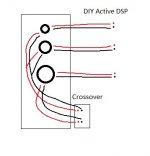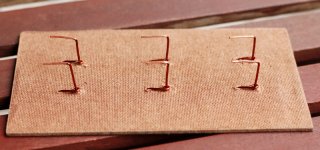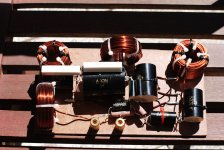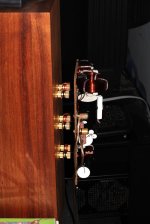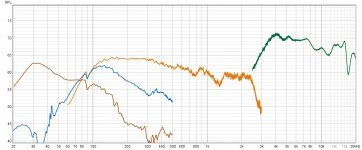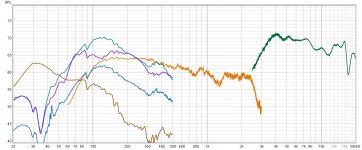I am thinking to implement an active DSP configuration into my system.
I will use 3 way speaker and I already bought a protection cap for the tweeter.
(Acoustic Energy Aegis Three, Acoustic Energy Aegis Three Floorstanding Speakers user reviews : 4.5 out of 5 - 28 reviews - audioreview.com)
To do so I should remove the passive crossover and wire each speaker directly to the amp.
Doing so, I wont be able to use them without my actual complex active DSP configuration which in my case is a PC, running Equalizer APO, external sound card and four stereo amplifiers.
My question is, could be posible to maintain the original passive crossover/wires to speakers and connect also the new wires to the speakers?
Then, just connect the amp to the new entries and leave unconnected the passive XO entries. I am concern about having the XO circuitry on the other end of the speakers
I made a diagram, I hope it understandable.
The speaker have bi-amp capabilities. One channel for the woofer and the other for mid and tweeter.
I will use 3 way speaker and I already bought a protection cap for the tweeter.
(Acoustic Energy Aegis Three, Acoustic Energy Aegis Three Floorstanding Speakers user reviews : 4.5 out of 5 - 28 reviews - audioreview.com)
To do so I should remove the passive crossover and wire each speaker directly to the amp.
Doing so, I wont be able to use them without my actual complex active DSP configuration which in my case is a PC, running Equalizer APO, external sound card and four stereo amplifiers.
My question is, could be posible to maintain the original passive crossover/wires to speakers and connect also the new wires to the speakers?
Then, just connect the amp to the new entries and leave unconnected the passive XO entries. I am concern about having the XO circuitry on the other end of the speakers
I made a diagram, I hope it understandable.
The speaker have bi-amp capabilities. One channel for the woofer and the other for mid and tweeter.
Attachments
'My question is, could be possible to maintain the original passive crossover/wires to speakers and connect also the new wires to the speakers?'
No
No
To avoid the inevitable mistake of the wrong switch position, I'd suggest external connections for each driver, and an external passive.
It is also a good idea to make it physically impossible to connect it wrong.
This involves spacing and wire length, and sometimes even different connectors.
You can have both, just be careful, blow up enough parts & amps, and it gets expensive.
It is also a good idea to make it physically impossible to connect it wrong.
This involves spacing and wire length, and sometimes even different connectors.
You can have both, just be careful, blow up enough parts & amps, and it gets expensive.
Yeah, good comments from all.
Bottom line is, any passive flow thru paths have to be eliminated with active.
I've gotten cute, making passive and active available with a multipole multi throw switch.
Not worth the time or trouble imo.
Do your best passive. Disconnect. Do your best active.
Judge by memory, it's almost always been clear to me which is better.
Or much better, keep one speaker passive and take another active, A/B compare.
Bottom line is, any passive flow thru paths have to be eliminated with active.
I've gotten cute, making passive and active available with a multipole multi throw switch.
Not worth the time or trouble imo.
Do your best passive. Disconnect. Do your best active.
Judge by memory, it's almost always been clear to me which is better.
Or much better, keep one speaker passive and take another active, A/B compare.
Even physically different connectors won't save you. While I haven't done it ("yet") if you use active EQ via a DSP, it's entirely too easy to send the bass signal to an expensive tweeter. Note this is on a custom-wired speaker with none of the idiot-proofing that must go into most commercial (Pro) products.
To avoid the inevitable mistake of the wrong switch position, I'd suggest external connections for each driver, and an external passive.
That is what I did. See attached.
Attachments
Last edited:
Sure, folks with DSP do it all the time like when you have one amp channel power a mid-range and tweeter. And I've often worried about turn-on voltages when connecting a delicate tweeter directly to an amp.
Now logically speaking, you can't have your DSP XO higher than your passive to the tweeter and also have your DSP XO lower than your mid or woofer, which you'd sort of have to do to keep the passive XOs from messing up the drive signal. But if you somehow used the same frequencies but added slope from the DSP.
OK, all this is speculative, but so is being needlessly purist about crossovers. My point being, there's nothing electrically incompatible with leaving the old crossover components in place if the final system works and you don't push the amps into an impedance region they can't handle.
B.
Now logically speaking, you can't have your DSP XO higher than your passive to the tweeter and also have your DSP XO lower than your mid or woofer, which you'd sort of have to do to keep the passive XOs from messing up the drive signal. But if you somehow used the same frequencies but added slope from the DSP.
OK, all this is speculative, but so is being needlessly purist about crossovers. My point being, there's nothing electrically incompatible with leaving the old crossover components in place if the final system works and you don't push the amps into an impedance region they can't handle.
B.
Last edited:
This has lead to good debate. I will think about having three multi-pole switches, one per driver.
The idea is to improve my speaker response, I attach two images with close range measurements
- Response 1: Tweeter, mid drive, low driver, bassreflex.
- Response 2: Just a test, DSP over low driver, +9db, gain adjusted -> Objective: expanse frequency response until 70hz. I don't play loud, but the final version could be only +6db, but in any case, i have the impression that those drivers are wasted in terms of SPL.
Other benefits I will hope to achieve:
- I suspect the low driver XO is no doing good work.
- There is severe overlap between low and mid driver. I will do better XO around 200-300hz.
- Frequency and phase fine adjustment to Impulse response. Again, talking specifically between low and mid driver, I am confident I will achieve better impulse response figures if low and mid drivers do not overlap.
- I read around internet that removing passive XO it will lead to drivers improvement removing passive components irregularities.
- Improve efficiency, less power to drive the drivers.
Cons:
- If i finally remove the physical XO, I could only run them with my configured PCs DSP.
- Driver measurements and complex DSP configuration. Not my biggest concern.
What do you thin about it?
The idea is to improve my speaker response, I attach two images with close range measurements
- Response 1: Tweeter, mid drive, low driver, bassreflex.
- Response 2: Just a test, DSP over low driver, +9db, gain adjusted -> Objective: expanse frequency response until 70hz. I don't play loud, but the final version could be only +6db, but in any case, i have the impression that those drivers are wasted in terms of SPL.
Other benefits I will hope to achieve:
- I suspect the low driver XO is no doing good work.
- There is severe overlap between low and mid driver. I will do better XO around 200-300hz.
- Frequency and phase fine adjustment to Impulse response. Again, talking specifically between low and mid driver, I am confident I will achieve better impulse response figures if low and mid drivers do not overlap.
- I read around internet that removing passive XO it will lead to drivers improvement removing passive components irregularities.
- Improve efficiency, less power to drive the drivers.
Cons:
- If i finally remove the physical XO, I could only run them with my configured PCs DSP.
- Driver measurements and complex DSP configuration. Not my biggest concern.
What do you thin about it?
Attachments
Estorkj, how about a more simple setup?
Since the speaker is biamped and you are questioning bass/mid xo, using DSP for that might be just enough and doesn't require opening boxes at all!
Buy a minidsp 2x4HD and find another 2ch amplifier. Minidsp input can be digital/USB or analog from you source (computer's soundcard, stereo?) Set routing so that input1 (eg. right channel) goes to output 1&2 and input 2 to output 3&4. Connect output 1 and 3 to one amp's L/R and it's speaker wires to woofers of left and right speakers. Minidsp Outputs 2&4 will got to other amp's L/R and then to L/R speakers' mid-tweeter inputs.
Then just some measuring/setup excersizes and presto!
Since the speaker is biamped and you are questioning bass/mid xo, using DSP for that might be just enough and doesn't require opening boxes at all!
Buy a minidsp 2x4HD and find another 2ch amplifier. Minidsp input can be digital/USB or analog from you source (computer's soundcard, stereo?) Set routing so that input1 (eg. right channel) goes to output 1&2 and input 2 to output 3&4. Connect output 1 and 3 to one amp's L/R and it's speaker wires to woofers of left and right speakers. Minidsp Outputs 2&4 will got to other amp's L/R and then to L/R speakers' mid-tweeter inputs.
Then just some measuring/setup excersizes and presto!
Last edited:
- Home
- Loudspeakers
- Multi-Way
- Pasive XO and Active DSP connections simultaneously
